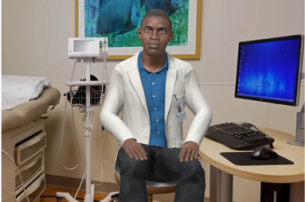Internet-based Tailored Virtual Human Health Intervention to Promote Colorectal Cancer Screening: Design Guidelines from Two User Studies

Colorectal cancer (CRC) is the second-leading cause of cancer deaths among men and women in the United States. While mortality rates can be cut in half by simply ensuring that patients adhere to current screening guidelines, many people do not take appropriate steps to educate themselves and take advantage of those screening options due to a variety of factors, including a fear of cancer, embarrassment, and the stigma associated with CRC in particular, as well as a general lack of awareness about screening options.
University of Florida researchers and colleagues, led by the UF STEM Translational Communication Center, are exploring new approaches to communicating health interventions to patients. One such intervention method is the use of an internet-based virtual humans (VH) which is a life-like animation of a healthcare workers that patients can access through an app. VHs have been shown to successfully influence patients in engaging in positive health behaviors such as losing weight and increasing physical activity, which is why current research works to extend this reach to those at risk for CRC.
A notable benefit of using a VH is that they can be deployed to large populations at reduced costs, while increasing the convenience for patients to readily access health information. Researchers have found that VH’s in particular are worthy of study because text-based interventions are not enough. Empathy, hand gestures, and other verbal and non-verbal means of communication help humanize the health intervention, thus making it more accessible and effective for users.
The scholars conducted two studies to determine guidelines for the continued design and appearance of VHs. Responses to different versions of VH were studied, to include both male and female, as well as Black and White. The research demonstrated that VH’s are useful to influencing the user intentions to screen for CRC. By using a logo and visual association of a local healthcare provider in conjunction with a VH, trust in the messaging is increased.
Linguistic attributes that lead to greater effectiveness of VH’s include the emotional tone of the VH communication and the readability of information in the app based on grade-level. Recommendations for further study include using linguistic analysis throughout development to continuously improve VH verbal communication in addition to the animation and visual characteristics.
Subjects did note the lack of realism with comments such as “I thought that the person in the app wasn’t very realistic. It looked plastic,” and “it was clearly somewhat awkward, herky-jerky.” Some subjects also noted that the VH in the app were not on par with present-day video game graphics. Initial impressions of the VH’s were typically about the VH’s visual design rather than the content of the information provided. Despite the critique of the images, key factors that positively influence patient reception to the VH include general visual realism, the healthcare role of the VH, and presence of a local healthcare provider’s logo.
The original research paper, “Internet-based tailored human health intervention to promote colorectal cancer screening: design guidelines from two user studies,” appeared in the Journal on Multimodal User Interfaces, Jan. 2, 2021.
Authors: Mohan Zalake, Fatemeh Tavassoli, Kyle Duke, Thomas George, Francois Modave, Jordan Neil, Janice Kreiger, Benjamin Lok
This summary was written by Marie Morganelli, Ph.D.


